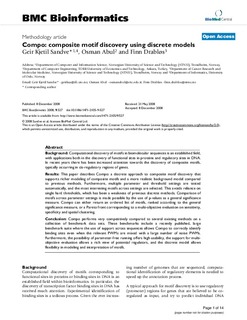| dc.contributor.author | Sandve, Geir Kjetil | |
| dc.contributor.author | Abul, Osman | |
| dc.contributor.author | Drabløs, Finn | |
| dc.date.accessioned | 2015-09-21T11:30:51Z | |
| dc.date.accessioned | 2015-12-03T14:48:15Z | |
| dc.date.available | 2015-09-21T11:30:51Z | |
| dc.date.available | 2015-12-03T14:48:15Z | |
| dc.date.issued | 2008 | |
| dc.identifier.citation | BMC Bioinformatics 2008, 9(527) | nb_NO |
| dc.identifier.issn | 1471-2105 | |
| dc.identifier.uri | http://hdl.handle.net/11250/2366787 | |
| dc.description.abstract | Background: Computational discovery of motifs in biomolecular sequences is an established field,
with applications both in the discovery of functional sites in proteins and regulatory sites in DNA.
In recent years there has been increased attention towards the discovery of composite motifs,
typically occurring in cis-regulatory regions of genes.
Results: This paper describes Compo: a discrete approach to composite motif discovery that
supports richer modeling of composite motifs and a more realistic background model compared
to previous methods. Furthermore, multiple parameter and threshold settings are tested
automatically, and the most interesting motifs across settings are selected. This avoids reliance on
single hard thresholds, which has been a weakness of previous discrete methods. Comparison of
motifs across parameter settings is made possible by the use of p-values as a general significance
measure. Compo can either return an ordered list of motifs, ranked according to the general
significance measure, or a Pareto front corresponding to a multi-objective evaluation on sensitivity,
specificity and spatial clustering.
Conclusion: Compo performs very competitively compared to several existing methods on a
collection of benchmark data sets. These benchmarks include a recently published, large
benchmark suite where the use of support across sequences allows Compo to correctly identify
binding sites even when the relevant PWMs are mixed with a large number of noise PWMs.
Furthermore, the possibility of parameter-free running offers high usability, the support for multiobjective
evaluation allows a rich view of potential regulators, and the discrete model allows
flexibility in modeling and interpretation of motifs. | nb_NO |
| dc.language.iso | eng | nb_NO |
| dc.publisher | BioMed Central | nb_NO |
| dc.title | Compo: composite motif discovery using discrete models | nb_NO |
| dc.type | Journal article | nb_NO |
| dc.type | Peer reviewed | en_GB |
| dc.date.updated | 2015-09-21T11:30:51Z | |
| dc.source.volume | 9 | nb_NO |
| dc.source.journal | BMC Bioinformatics | nb_NO |
| dc.identifier.doi | 10.1186/1471-2105-9-527 | |
| dc.identifier.cristin | 360192 | |
| dc.description.localcode | © 2008 Sandve et al; licensee BioMed Central Ltd. This is an Open Access article distributed under the terms of the Creative Commons Attribution License (http://creativecommons.org/licenses/by/2.0), which permits unrestricted use, distribution, and reproduction in any medium, provided the original work is properly cited. | nb_NO |
